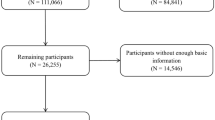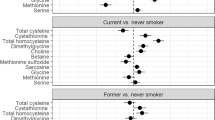Abstract
Background/Objectives
Cancerous and non-cancerous respiratory diseases are common and contribute significantly to global disease burden. We aim to quantify the association between plasma vitamin C concentrations as an indicator of high fruit and vegetable consumption and the risk of incident respiratory diseases and associated mortality in a general population.
Subjects/Methods
Nineteen thousand three hundred and fifty-seven men and women aged 40–79 years without prevalent respiratory diseases at the baseline (1993–1997) and participating in the European Prospective Investigation into Cancer (EPIC)-Norfolk study in the United Kingdom were followed through March 2015 for both incidence and mortality from respiratory diseases.
Results
There were a total of 3914 incident events and 407 deaths due to any respiratory diseases (excluding lung cancers), 367 incident lung cancers and 280 lung cancer deaths during the follow-up (total person-years >300,000 years). Cox's proportional hazards models showed that persons in the top quartiles of baseline plasma vitamin C concentrations had a 43% lower risk of lung cancer (hazard ratio (HR) 0.57; 95% confidence interval (CI): 0.41–0.81) than did those in the bottom quartile, independently of potential confounders. The results are similar for any non-cancerous respiratory diseases (HR 0.85; 0.77–0.95), including chronic respiratory diseases (HR 0.81; 0.69–0.96) and pneumonia (HR 0.70; 0.59–0.83). The corresponding values for mortality were 0.54 (0.35–0.81), 0.81 (0.59–1.12), 0.85 (0.44–1.66) and 0.61 (0.37–1.01), respectively. Confining analyses to non-smokers showed 42% and 53% risk reduction of non-smoking-related lung cancer incidence and death.
Conclusions
Higher levels of vitamin C concentrations as a marker of high fruit and vegetable consumption reduces the risk of cancerous and non-cancerous respiratory illnesses including non-smoking-related cancer incidence and deaths.
This is a preview of subscription content, access via your institution
Access options
Subscribe to this journal
Receive 12 print issues and online access
$259.00 per year
only $21.58 per issue
Buy this article
- Purchase on Springer Link
- Instant access to full article PDF
Prices may be subject to local taxes which are calculated during checkout

Similar content being viewed by others
References
Gupta R, Limb E. The burden of lung disease: a statistics report from the British Thoracic Society. 2nd ed; 2006. https://www.brit-thoracic.org.uk/document-library/delivery-of-respiratory-care/burden-of-lungdisease/burden-of-lung-disease-2006/ Accessed 27 Nov 2014.
Khaw KT, Bingham S, Welch A, Luben R, Wareham N, Oakes S, et al. Relation between plasma ascorbic acid and mortality in men and women in EPIC-Norfolk prospective study: a prospective population study. European Prospective Investigation into Cancer and Nutrition. Lancet. 2001;357:657–63.
Myint PK, Luben RN, Welch AA, Bingham SA, Wareham NJ, Khaw KT. Plasma vitamin C concentrations predict risk of incident stroke over 10 y in 20 649 participants of the European Prospective Investigation into Cancer Norfolk prospective population study. Am J Clin Nutr. 2008;87:64–9.
Myint PK, Luben RN, Wareham NJ, Bingham SA, Khaw KT. Combined effect of health behaviours and risk of first ever stroke in 20,040 men and women over 11 years’ follow-up in Norfolk cohort of European Prospective Investigation of Cancer (EPIC Norfolk): prospective population study. BMJ. 2009;338:b349.
Ness AR, Powles JW, Khaw KT. Vitamin C and cardiovascular disease: a systematic review. J Cardiovasc Risk. 1996;3:513–21.
Yokoyama T, Date C, Kokubo Y, Yoshiike N, Matsumura Y, Tanaka H. Serum vitamin C concentration was inversely associated with subsequent 20-year incidence of stroke in a Japanese rural community. The Shibata Study. Stroke. 2000;31:2287–94.
Voko Z, Hollander M, Hofman A, Koudstaal PJ, Breteler MM. Dietary antioxidants and the risk of ischemic stroke: the Rotterdam Study. Neurology. 2003;61:1273–5.
Food Standard Agency. EVM review of vitamin C. Eat well, be well. Helping you make healthier choices. http://www.food.gov.uk/multimedia/pdfs/evm_c.pdf. Accessed 15 Sep 2014.
Hickey S, Roberts H. Ascorbate: the science of vitamin C. Napa, CA: Lulu Press, Inc.; 2004. ISBN 1-4116-0724-4.
Hickey S, Roberts H. Misleading information on the properties of vitamin C. PLoS Med. 2005;2:e307.
Day N, Oakes S, Luben R, Khaw KT, Bingham S, Welch A, et al. EPIC-Norfolk: study design and characteristics of the cohort. European Prospective Investigation of Cancer. Br J Cancer. 1999;80 Suppl 1:95–103.
Cox B, Huppert F, Whichelow M. The health and lifestyle survey: seven years on. Aldershot, UK: Dartmouth Publishing Company; 1993.
Wareham NJ, Jakes RW, Rennie KL, Schuit J, Mitchell J, Hennings S, et al. Validity and repeatability of a simple index derived from the short physical activity questionnaire used in the European Prospective Investigation into Cancer and Nutrition (EPIC) study. Public Health Nutr. 2003;6:407–13.
Elias P, Halstead K, Prandy K. CASOC: computer-assisted standard occupational coding. London, UK: HMSO; 1993.
Shohaimi S, Luben R, Wareham N, Day N, Bingham S, Welch A, et al. Residential area deprivation predicts smoking habit independently of individual educational level and occupational social class. A cross sectional study in the Norfolk cohort of the European Prospective Investigation into Cancer (EPIC-Norfolk). J Epidemiol Community Health. 2003;57:270–6.
Townsend P, Phillimore P, Beattie A. Health and deprivation: inequality and the north. London: Routledge; 1988.
Welch AA, Luben R, Khaw KT, Bingham SA. The CAFE computer program for nutritional analysis of the EPIC-Norfolk food frequency questionnaire and identification of extreme nutrient values. J Hum Nutr Diet. 2005;18:99–116.
Vuilleumier J, Keck E. Fluorometric assay of vitamin C in biological materials using a centrifugal analyser with fluorescence attachment. J Micronutr Anal. 1989;5:25–34.
Sinha S, Myint PK, Luben RN, Khaw KT. Accuracy of death certification and hospital record linkage for identification of incident stroke. BMC Med Res Methodol. 2008;8:74.
Roca J, Burgos F, Sunyer J, Saez M, Chinn S, Antó JM, et al. References values for forced spirometry. Group of the European Community Respiratory Health Survey. Eur Respir J. 1998;11:1354–62.
Luo J, Shen L, Zheng D. Association between vitamin C intake and lung cancer: a dose–response meta-analysis. Sci Rep. 2014;4:6161.
Wu TC, Huang YC, Hsu SY, Wang YC, Yeh SL. Vitamin E and vitamin C supplementation in patients with chronic obstructive pulmonary disease. Int J Vitam Nutr Res. 2007;77:272–9.
Heart Protection Study Collaborative Group. MRC/BHF Heart Protection Study of antioxidant vitamin supplementation in 20,536 high-risk individuals: a randomised placebo-controlled trial. Lancet. 2002;360:23–33.
Hemilä H, Louhiala P. Vitamin C for preventing and treating pneumonia. Cochrane Database Syst Rev. 2013;8:CD005532.
McKeever TM, Lewis SA, Smit HA, Burney P, Cassano PA, Britton J. A multivariate analysis of serum nutrient levels and lung function. Respir Res. 2008;9:67.
Ochs-Balcom HM, Grant BJ, Muti P, Sempos CT, Freudenheim JL, Browne RW, et al. Antioxidants, oxidative stress, and pulmonary function in individuals diagnosed with asthma or COPD. Eur J Clin Nutr. 2006;60:991–9.
Ford ES, Li C, Cunningham TJ, Croft JB. Associations between antioxidants and all-cause mortality among US adults with obstructive lung function. Br J Nutr. 2014;112:1662–73.
Ahmadi A, Haghighat N, Hakimrabet M, Tolide-ie H. Nutritional evaluation in chronic obstructive pulmonary disease patients. Pak J Biol Sci. 2012;15:501–5.
ben Anes A, Fetoui H, Bchir S, ben Nasr H, Chahdoura H, Chabchoub E, et al. Increased oxidative stress and altered levels of nitric oxide and peroxynitrite in Tunisian patients with chronic obstructive pulmonary disease: correlation with disease severity and airflow obstruction. Biol Trace Elem Res. 2014;161:20–31.
Koike K, Ishigami A, Sato Y, Hirai T, Yuan Y, Kobayashi E, et al. Vitamin C prevents cigarette smoke-induced pulmonary emphysema in mice and provides pulmonary restoration. Am J Respir Cell Mol Biol. 2014;50:347–57.
Li W, Maeda N, Beck MA. Vitamin C deficiency increases the lung pathology of influenza virus-infected gulo−/− mice. J Nutr. 2006;136:2611–6.
Hamer DH, Sempértegui F, Estrella B, Tucker KL, Rodríguez A, Egas J, et al. Micronutrient deficiencies are associated with impaired immune response and higher burden of respiratory infections in elderly Ecuadorians. J Nutr. 2009;139:113–9.
Acknowledgements
We would like to thank the participants of the EPIC-Norfolk cohort. We thank the nutritionist team and data management team of the EPIC-Norfolk cohort.
Funding
The EPIC-Norfolk study was supported by grants from the Medical Research Council and Cancer Research UK. The funders and sponsors had no role in design and the data collection, analysis, and interpretation of data and the writing of the article and the decision to submit it for publication.
Author contributions
PKM: design, write up, primary responsibility for final content. AMW: design, write up. ABC: data analysis, write up. RNL: data linkage, write up. NJW: design, provide data, write up. K-TK: design, provide data, write up.
Author information
Authors and Affiliations
Corresponding author
Ethics declarations
Conflict of interest
The authors declare that they have no conflict of interest.
Additional information
Publisher’s note: Springer Nature remains neutral with regard to jurisdictional claims in published maps and institutional affiliations.
Supplementary information
Rights and permissions
About this article
Cite this article
Myint, P.K., Wilson, A.M., Clark, A.B. et al. Plasma vitamin C concentrations and risk of incident respiratory diseases and mortality in the European Prospective Investigation into Cancer-Norfolk population-based cohort study. Eur J Clin Nutr 73, 1492–1500 (2019). https://doi.org/10.1038/s41430-019-0393-1
Received:
Revised:
Accepted:
Published:
Issue Date:
DOI: https://doi.org/10.1038/s41430-019-0393-1
This article is cited by
-
Serum antioxidant vitamins and respiratory morbidity and mortality: a pooled analysis
Respiratory Research (2022)
-
Dietary total antioxidant capacity and mortality outcomes: the Singapore Chinese Health Study
European Journal of Nutrition (2022)



